The Heritage of Industrial Modernization
The Development of Modern Silk: From Joshu to Shinshu and Across the Nation
What exactly is the heritage of industrial modernization?
Across Japan there is a large inheritance of structures, machines, and documentation that tells the story of Japan’s industrial modernization. Spanning the period between the mid-1800s until just prior World War II, it has been passed down to this day.
In 1993, the Ministry of Economy, Trade, and Industry created the “Heritage of Industrial Modernization” to encourage the use of regional and industrial history as a tourist draw.
Fifteen local silk reeling industries’ properties applied to the Ministry of Economy, Trade, and Industry for designation as part of the “Heritage of Industrial Modernization Group: From Joshu to Shinshu and across the nation, telling the story of the silk industry’s development through properties like the Tomioka Silk Mill. All fifteen were approved.
Tsurumine Park
 Katakura-gumi was one of Japan’s premier silk reeling companies. Now, thousands of azaleas are planted at the location of its former training center. It is the most well known azalea viewing spot in central Japan.
Katakura-gumi was one of Japan’s premier silk reeling companies. Now, thousands of azaleas are planted at the location of its former training center. It is the most well known azalea viewing spot in central Japan.
Former Katakura-gumi Headquarters
 The aforementioned silk company’s office, constructed in 1910.
The aforementioned silk company’s office, constructed in 1910.
Former Hayashi Residence
 Kunizo Hayashi was the head of a silk reeling company. His residence was also used to entertain foreign guests. The Japanese style room with kinkarakawa-gami (thin leather wallpaper with gold patterns) is worth a look.
Kunizo Hayashi was the head of a silk reeling company. His residence was also used to entertain foreign guests. The Japanese style room with kinkarakawa-gami (thin leather wallpaper with gold patterns) is worth a look.
Narita Park
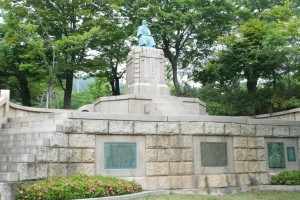 A well known cherry blossom spot, people held ceremonies here for the success of the silk industry. There’s also a well rendered statue of Takajiro Kurosawa, a bank president who supported the silk industry’s development.
A well known cherry blossom spot, people held ceremonies here for the success of the silk industry. There’s also a well rendered statue of Takajiro Kurosawa, a bank president who supported the silk industry’s development.
Maruyama Tank
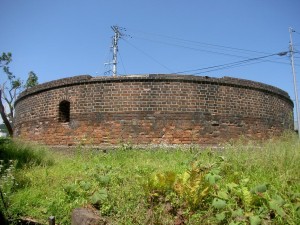 A water tank that supplied the silk mills with water for cocoon cooking and reeling, for boiler and other processes. Water from the Tenryu River would be stored there on the hill until distributed.
A water tank that supplied the silk mills with water for cocoon cooking and reeling, for boiler and other processes. Water from the Tenryu River would be stored there on the hill until distributed.
Former Yamaichi Hayashi-gumi Silk Mill Office
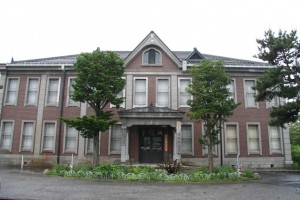 The office of Okaya’s fourth largest silk mill. Now it houses the Okaya Silk Wearing Studio.
The office of Okaya’s fourth largest silk mill. Now it houses the Okaya Silk Wearing Studio.
Kinjo Corporation’s Cocoon Storehouse
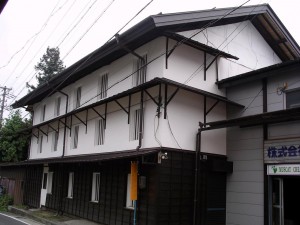 A silk family’s cocoon storehouse. Currently owned by the Kinjo Corporation, it’s one of the few storehouses left in town.
A silk family’s cocoon storehouse. Currently owned by the Kinjo Corporation, it’s one of the few storehouses left in town.
Silkworm Memorial Tower
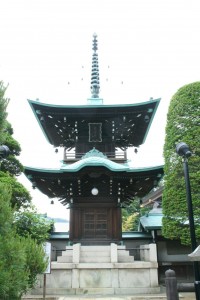 Erected on the grounds of Shoko-ji Temple by patrons of the silk industry, this memorial tower was offered for the repose of silkworms sacrificed to develop the industry, and to pray for the growth of sericulture.
Erected on the grounds of Shoko-ji Temple by patrons of the silk industry, this memorial tower was offered for the repose of silkworms sacrificed to develop the industry, and to pray for the growth of sericulture.
Former Okaya Water Works Facility
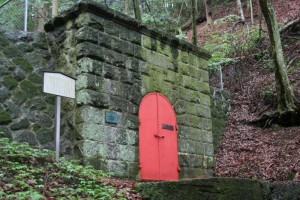 Collecting groundwater from the nearby hills, this facility supplied municipal and industrial water during Okaya’s silk industry heyday (1910-1930). It was in use until 1988.
Collecting groundwater from the nearby hills, this facility supplied municipal and industrial water during Okaya’s silk industry heyday (1910-1930). It was in use until 1988.
Okaya Silk Museum’s Machinery Collection
 This museum is dedicated to preserving and transmitting the history of the silk industry that modernized Japan. On display is the only French silk reeling machine left in the nation, a Suwa-type reeling machine, and other rare machinery and documentation.
This museum is dedicated to preserving and transmitting the history of the silk industry that modernized Japan. On display is the only French silk reeling machine left in the nation, a Suwa-type reeling machine, and other rare machinery and documentation.
Former Okaya City Hall
 This Okaya City Hall was gifted to the city in 1936 by Fukutaro Ozawa’s silk reeling factory to commemorate establishment of the municipal system.
This Okaya City Hall was gifted to the city in 1936 by Fukutaro Ozawa’s silk reeling factory to commemorate establishment of the municipal system.
Former Sericultural Experiment Station
 Formerly a research facility dedicated to improve silk reeling technology, now it is the home of the Okaya Silk Museum. Items such as a multi-end silk reeling machine and etc are on display.
Formerly a research facility dedicated to improve silk reeling technology, now it is the home of the Okaya Silk Museum. Items such as a multi-end silk reeling machine and etc are on display.
Shin-Masuzawa Industrial Corporation’s Machinery Collection
 This company was established in 1986, and continued to this day.This company had produced a large number of silk reeling machines wring a “Plane Milling Machine” is one of metal cutting machines.
This company was established in 1986, and continued to this day.This company had produced a large number of silk reeling machines wring a “Plane Milling Machine” is one of metal cutting machines.
Former Yamajo Miyasaka Silk Mill
 This silk mill was established in 1874. The cocoon storage house, silk reeling house, office, and residences remain as a single complex.
This silk mill was established in 1874. The cocoon storage house, silk reeling house, office, and residences remain as a single complex.
Marunaka Miyasaka Silk Mill (Cocoon Storage house)
 This cocoon storage house was used by a silk mill established in 1928. It now annexes the Okaya Silk Museum, where the Miyasaka Silk Mill produces raw silk.
This cocoon storage house was used by a silk mill established in 1928. It now annexes the Okaya Silk Museum, where the Miyasaka Silk Mill produces raw silk.
